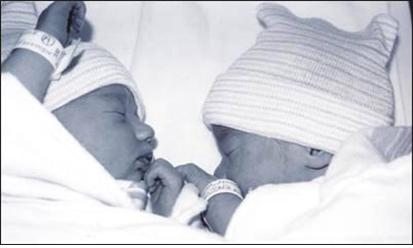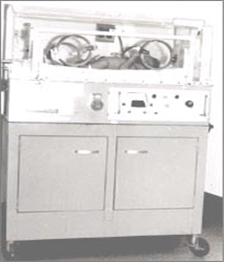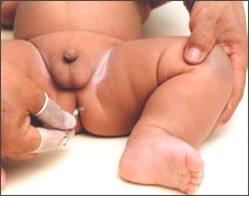만삭 신생아와미숙 신생아의 정상 체온 Normal temperature of full term newborn infants and premature infants

사진 2.
신생아들은 자신들의 체온을 성숙하게 조절하지 못한다.
특히 미숙 신생아들은 체온조절을 하는데 어려움이 많다.
체온을 적절히 유지하기 위해서 신생아들에게 모자를 씌우고 옷을 따뜻하게 잘 입힌다.
그리고 포대기나 담요 등으로 적절히 잘 싸서 체온이 떨어지지 않게 보호 양육해 주어야 한다.
때로는 어떤 이유든 자신이 체온을 잘 조절할 수 없는 미숙 신생아들이나 신생아들을 보육기 속에서 양육하다가 그 다음으로 크립으로 옮겨 양육하고 필요에 따라 보육기 속에서 치료도 해주고 그들 자신들이 체온을 잘 조절할 수 있고
그들의 체중이 계속 증가되고 건강하면 집으로 퇴원시키는 식으로 그들을 양육하는 것이 보통이다.
Copyright ⓒ 2011 John Sangwon Lee, MD., FAAP

사진 3.
만삭에 태어난 정상 신생아들, 병을 앓는 만삭 신생아들이나 체중이 아주 작은 미숙아들은 신생아기 이후 건강한 큰 아기들처럼 체온 조절을 스스로 잘 하지 못하는 것이 보통이다. 그들이 스스로 체온을 잘 조절 할 수 있을 때까지 필요에 따라 인큐베이터(보육기) 내에서 얼마동안 양육할 때가 많다.Copyright ⓒ 2011 John Sangwon Lee, MD., FAAP

사진 4.
만삭 신생아들, 특히 어떤 병을 앓는 신생아들, 아주 작은 미숙아들은 신생아기 이후 건강한 아기들처럼 체온 조절을 스스로 잘 못하는 것이 보통이다. 이런 이유로 체온 조절을 스스로 잘 할 수 있을 때까지 미숙아를 인큐베이터(보육기) 내서 양육하고 필요에 따라 치료도 하는 것이 보통이다.
Copyright ⓒ 2011 John Sangwon Lee, MD., FAAP

사진 5. 항문 체온을 잰다.
Copyright ⓒ 2011 John Sangwon Lee, MD., FAAP
-
강한 신생아들의 체온 조절 중추 기능에 비해 덜 발육되어 있고 더 미숙하게 기능한다.
-
일반적으로 미숙 신생아들의 체표면적의 크기는 자신들의 체중에 비하여 더 넓고 피하 지방 조직은 더 얇다.
-
이런저런 이유로 대부분의 미숙 신생아들은, 특히 저 체중 미숙 신생아들은 상당히 크게 성장할 때까지 스스로 체온 조절을 잘 못하는 것이 보통이다.
-
주위 온도가 갑자기 높아지면 미숙 신생아들의 체온은 주위 온도에 따라 덩달아 올라가고 그와 반대로 주위 온도가 갑자기 내려가면 미숙 신생아의 체온이 주위 온도에 따라 덩달아 내려갈 수 있다.
-
출생 시 체중이 2.5kg 이하 되는 미숙 신생아들이나 저체중 신생아들이 스스로 체온을 잘 조절할 수 있을 때까지 그들을 보육기 속에서 양육하는 것이 일반적이다. [부모도 반의사가 되어야 한다–소아가정간호백과]-제6권 신생아 성장 발육 육아 및 질환–신생아의 체온, 신생아 탈수열 참조
Normal temperature of full term newborn infants and premature infants

photo 2. Newborns do not maturely regulate their body temperature. In particular, premature newborns have many difficulties in regulating body temperature.
To maintain proper body temperature, put a hat on the newborn and dress it well. In addition, they should be properly wrapped in a blanket or blanket to protect and nurture them so that their body temperature does not fall. Sometimes, for some reason, premature newborns or newborns who cannot control their own body temperature are raised in an incubator, then transferred to a creep, and treated in an incubator if necessary, and they themselves can regulate their body temperature well. It is common to raise them by discharging them home if they continue to gain weight and are healthy. Copyright ⓒ 2011 John Sangwon Lee, MD., FAAP

Photo 3. Normal newborns born at full term, full-term newborns with disease, or premature babies with very small weight are usually not as good at regulating body temperature as healthy, older babies after newborn. They are often raised for some time in an incubator (incubator) as needed until they can control their own body temperature. Copyright ⓒ 2011 John Sangwon Lee, MD., FAAP

Photo 4. Full-term newborns, especially newborns with certain diseases, and very small premature babies, are usually not as good at regulating their body temperature as healthy babies after newborn. For this reason, it is common to raise premature infants in an incubator (incubator) until they can control their body temperature well, and to treat them if necessary. Copyright ⓒ 2011 John Sangwon Lee, MD., FAAP

Photo 5. Take the temperature of the anus. Copyright ⓒ 2011 John Sangwon Lee, MD., FAAP
• Less developed and more immaturely functioning than the thermoregulatory centers of strong newborns.
• In general, premature newborns have a larger body surface area for their body weight and thinner subcutaneous adipose tissue.
• For one reason or another, most premature newborns, especially low-weight premature babies, are not normally able to self-regulate their body temperature well until they are quite large.
• When the ambient temperature rises suddenly, the body temperature of premature newborns rises in accordance with the ambient temperature. Conversely, when the ambient temperature suddenly decreases, the body temperature of premature newborns may drop along with the ambient temperature.
• It is common for premature or low birth weight newborns weighing less than 2.5 kg at birth to be brought up in incubators until they are able to regulate their body temperature. www.drleepediatrics.com – Volume 6 Newborn Growth, Development, Parenting and Diseases – Newborn body temperature, Newborn dehydration fever
출처 및 참조 문헌 Sources and references
- NelsonTextbook of Pediatrics 22ND Ed
- The Harriet Lane Handbook 22ND Ed
- Growth and development of the children
- Red Book 32nd Ed 2021-2024
- Neonatal Resuscitation, American Academy of Pediatrics
- www.drleepediatrics.com 제 6권 신생아 성장 발육 육아 질병
- www.drleepediatrics.com제7권 소아청소년 감염병
- www.drleepediatrics.com제8권 소아청소년 호흡기 질환
- www.drleepediatrics.com제9권 소아청소년 소화기 질환
- www.drleepediatrics.com제10권. 소아청소년 신장 비뇨 생식기 질환
- www.drleepediatrics.com제11권. 소아청소년 심장 혈관계 질환
- www.drleepediatrics.com제12권. 소아청소년 신경 정신 질환, 행동 수면 문제
- www.drleepediatrics.com제13권. 소아청소년 혈액, 림프, 종양 질환
- www.drleepediatrics.com제14권. 소아청소년 내분비, 유전, 염색체, 대사, 희귀병
- www.drleepediatrics.com제15권. 소아청소년 알레르기, 자가 면역질환
- www.drleepediatrics.com제17권. 소아청소년 피부 질환
- www.drleepediatrics.com제18권. 소아청소년 이비인후(귀 코 인두 후두) 질환
- www.drleepediatrics.com제19권. 소아청소년 안과 (눈)질환
- www.drleepediatrics.com 제 20권 소아청소년 이 (치아)질환
- www.drleepediatrics.com 제21권 소아청소년 가정 학교 간호
- Red book 29th-31st edition 2021
- Nelson Text Book of Pediatrics 19th — 21st Edition
- The Johns Hopkins Hospital, The Harriet Lane Handbook, 22nd edition
-
Childhood Emergencies in the Office, Hospital and Community, American Academy of Pediatrics
-
Emergency Medical Service for Children, By Ross Lab. May 1989. p.10
-
Emergency care, Harvey grant, and Robert Murray
-
Emergency Care Transportation of Sick and Injured American Academy of Orthopaedic Surgeons
-
Emergency Pediatrics A Guide to Ambulatory Care, Roger M. Barkin, Peter Rosen
-
Immediate care of the acutely ill and injured, Hugh E. Stephenson, Jr
-
The Critically Ill Child, Diagnosis and Management, Edited by Clement A. Smith
-
Emergency Medical Services for Children: The Role of the Primary Care Provider, America Academy of Pediatrics
-
Quick Reference To Pediatric Emergencies, Delmer J. Pascoe, M.D., Moses Grossman, M.D. with 26 contributors
-
Manual of Emergency Care
-
응급환자관리 정담미디어
-
소아가정간호백과–부모도 반의사가 되어야 한다, 이상원
-
Neonatal Resuscitation American heart Association
-
Neonatology Jeffrey J.Pomerance, C. Joan Richardson
-
Pediatric Resuscitation Pediatric Clinics of North America, Stephen M. Schexnayder, M.D.
-
Pediatric Critical Care, Pediatric Clinics of North America, James P. Orlowski, M.D.
-
Preparation for Birth. Beverly Savage and Dianna Smith
- Infectious disease of children, Saul Krugman, Samuel L Katz, Ann A. Gershon, Catherine Wilfert
-
The Harriet Lane Handbook 19th Edition
-
소아과학 대한교과서
-
제1권 소아청소년 응급의료 참조문헌과 출처
-
Other
Copyright ⓒ 2015 John Sangwon Lee, MD., FAAP
“부모도 반의사가 되어야 한다”-내용은 여러분들의 의사로부터 얻은 정보와 진료를 대신할 수 없습니다.
“The information contained in this publication should not be used as a substitute for the medical care and advice of your doctor. There may be variations in treatment that your doctor may recommend based on individual facts and circumstances. “Parental education is the best medicine.”